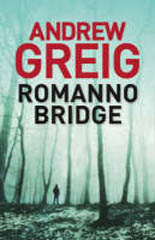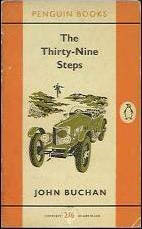In Darkest Peeblesdale
The historian Macaulay made a neat distinction between imitating and parodying: writing about Dr Johnson, he said that the great Doctor had been imitated by his admirers and parodied by his assailants. Greig’s first foray into John Buchan’s world was in his 1996 The Return of John McNab, which was shortlisted for the Romantic Novelists’ Association Award. Now that he has produced a second Buchan-inspired thriller, it is difficult to know whether Greig is writing in imitation or emulation, parody or homage.
 Greig’s contemporary dark adventure ‘step[s] back into the great peat bog’ of Scotland, ‘where myth and history ooze together’ to tell the story of the crowning Stone of Scone and the quest to establish its location, though not its complete liberation or restoration to its proper place. The main narrative opens symbolically, in winter, with a death in the forest of Rothiemurchus, moving to ‘douce, respectable’ Dumfries, through an area called Peeblesdale, via the Tibetan monastery of Samye Ling at Eskdalemuir, and over other parts of the country, before taking off in flight to Norway and Sweden. Set a few years before the reconvening of the Scottish Parliament in 1999, various narratives and sub-plots are woven in and through, cutting across the main narrative, driving the story along at a devilish pace.
Greig’s contemporary dark adventure ‘step[s] back into the great peat bog’ of Scotland, ‘where myth and history ooze together’ to tell the story of the crowning Stone of Scone and the quest to establish its location, though not its complete liberation or restoration to its proper place. The main narrative opens symbolically, in winter, with a death in the forest of Rothiemurchus, moving to ‘douce, respectable’ Dumfries, through an area called Peeblesdale, via the Tibetan monastery of Samye Ling at Eskdalemuir, and over other parts of the country, before taking off in flight to Norway and Sweden. Set a few years before the reconvening of the Scottish Parliament in 1999, various narratives and sub-plots are woven in and through, cutting across the main narrative, driving the story along at a devilish pace.
In the preface to The Thirty-Nine Steps, John Buchan wrote to the book’s dedicatee, ‘you and I have long cherished an affection for that elemental type of tale which Americans call the ‘dime novel’ and which we know as the ‘shocker’ – the romance where the incidents defy the probabilities, and march just inside the borders of the possible… this little volume is the result… [and is written] in memory of our long friendship, in the days when the wildest fictions are so much less improbable than the facts.’ In Greig’s romance, some of ‘the incidents also defy the probabilities’, but this is the stuff of the adventure-story and of the thriller.
 Many of Buchan’s original staples, or variations thereon, are to be found in Romanno Bridge: central to the story are the knavish plots that threaten aspects of national security and the implications that the theft of the Scone Stone may have for the Union. Here the dangerously evil foreigner is replaced with a kind of bogey-man – this one in the form of a native Scot, one Adamson (not unlike the psychopath Binks in Stephen Greenhorn’s 1997 play Passing Places), who had been, amongst other things, ‘lead shouter in a punk band called Anger Management’. Included, and taking place at greater speed, are the great Buchanesque car chases. And as in Buchan, there are in Romanno Bridge some very fine descriptions of landscape – as well as being a storyteller, Greig is a poet. Gone are the old xenophobic and imperialistic attitudes that permeate Buchan’s shockers; Romanno Bridge could be described as positively multicultural. And gone too is the homosocial milieu typical of Buchan’s fictions. Given the tradition to which Romanno Bridge belongs, there persists, however, a certain amount of deference, in this case towards HRH the Duke of Rothesay. This seems to be a necessary element to the plot. Never to be countenanced though, in the novels of that son of the Presbyterian manse are the sex scenes, which some readers might think could qualify for shortlisting for the Bad Sex in Fiction Award of the Literary Review.
Many of Buchan’s original staples, or variations thereon, are to be found in Romanno Bridge: central to the story are the knavish plots that threaten aspects of national security and the implications that the theft of the Scone Stone may have for the Union. Here the dangerously evil foreigner is replaced with a kind of bogey-man – this one in the form of a native Scot, one Adamson (not unlike the psychopath Binks in Stephen Greenhorn’s 1997 play Passing Places), who had been, amongst other things, ‘lead shouter in a punk band called Anger Management’. Included, and taking place at greater speed, are the great Buchanesque car chases. And as in Buchan, there are in Romanno Bridge some very fine descriptions of landscape – as well as being a storyteller, Greig is a poet. Gone are the old xenophobic and imperialistic attitudes that permeate Buchan’s shockers; Romanno Bridge could be described as positively multicultural. And gone too is the homosocial milieu typical of Buchan’s fictions. Given the tradition to which Romanno Bridge belongs, there persists, however, a certain amount of deference, in this case towards HRH the Duke of Rothesay. This seems to be a necessary element to the plot. Never to be countenanced though, in the novels of that son of the Presbyterian manse are the sex scenes, which some readers might think could qualify for shortlisting for the Bad Sex in Fiction Award of the Literary Review.
Romanno Bridge is first and last an entertainment. And not a bad one at that. For those looking for something deeper in Greig’s thriller, and who might wish to see it as belonging, even marginally, to the genre of the modern Scottish political thriller, then an underlying political message may just be detectable. Towards the close, the narrator tells us that the importance of the Stone remains symbolic, and ‘however loaded, symbols cannot lastingly redeem our lives’, and so some may choose to see this entertainment as a unionist novel that warns us of the dangers of independence and the emptiness of symbols.
Romanno Bridge is published by Quercus. ISBN 9781847243157. Hardback. £14.99
AMAZON_SIDEBAR_TEXT <andrew,greig> <Buy books by Andrew Greig>
The John Buchan Centre, situated at the south end of Broughton village on the A701 twenty-nine miles south of Edinburgh, is open from 1 May to 15 October, 2-5 p.m. www.johnbuchansociety.co.uk
© Michael Lister

Comments